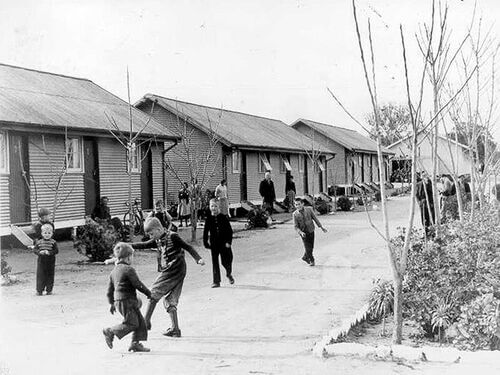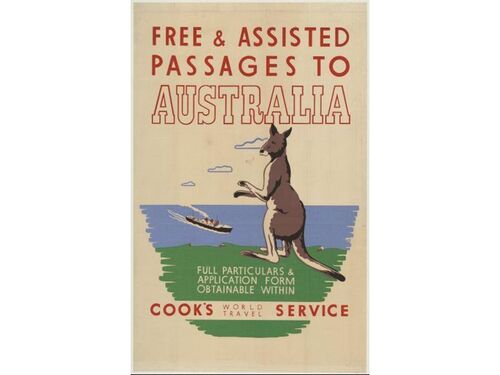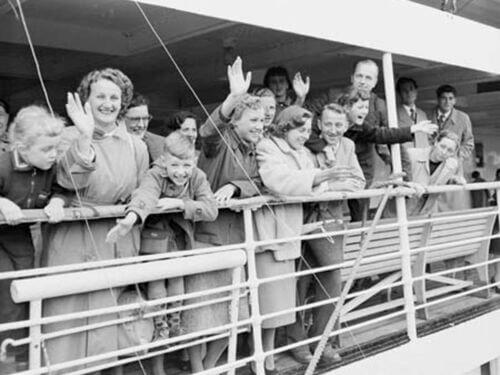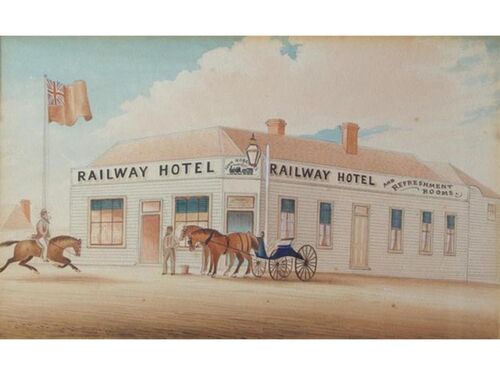Dutch Migration
A New History of the Dutch Immigration to Creswick
The Creswick and District Historical Society, Inc. has produced a new history of the Dutch immigration to Creswick, provided by the Creswick Dutch themselves. It is a record of the reasons for their immigration to Australia and to Creswick in particular, and their findings on arrival. A list of Dutch arrivals is also included.
It is hoped that this essay will be of benefit to those who wish to explore the origins of our predecessors...
CRESWICK WELCOMES THE DUTCH
By Jack van Beveren, Gerarda van Hamond, Jo van Oostveen, Rita Flapper & Marilyn Lennox
The Dutch have been a great boon to Victoria. Since their first appearance in the 1850s, as part of the gold rush period, to the present time, in which almost 20,000 Netherlands-born people live and work here. For the most part, the Dutch have settled into the Australian way of life and do not think of “going home”. They are hard-working, family oriented and thrifty. Their homes and work are here and they are happy with that.
During World War 2, the Netherlands at first hoped to be neutral and avoid involvement in what, it seemed, would be a repeat of the land-hungry, war-mongering of the German government of 1914. This was not to be. Within a few months the German army invaded and disabled the Netherlands economy, farming, shipping, manufacturing and commerce. The country was now hostage to the whims of war. In the coup de grace, Germany bombed the city of Rotterdam almost flat. The privations suffered by the Dutch people were as bad or worse than the French, Belgian, Danish, British and other European populations.
When peace came it was a great relief and was welcomed by all. But as those caught up in the war returned, it became obvious that the country would be crippled by poverty, homelessness, starvation and lack of government leadership for years to come. Large families shared lodgings with friends and relations for a while but as circumstances failed to improve, people began to take notice of Immigration posters that appeared on walls and in the newspapers.
The Dutch and Australian governments drew up an agreement that Dutch people would be assisted by way of inexpensive fares, help with finding work and housing if they agreed to immigrate to Australia. Other countries such as the USA, Canada and New Zealand were also keen to take part, seeing this as a fortuitous way of populating their countries. The first wave of immigrants was in 1947 when 625 Netherlands-born people were recorded; by 1954 the number rose to 15,996 applicants and in another five years the number had become 36,284. Some of these also came from Indonesia after that country gained independence from The Netherlands in 1949.
Families had long discussions about their prospects in Australia, leaving their family behind, and the thought that they might never have the funds to return. It was a daunting prospect, but decisions were made to take the opportunity of a new life - and make it work. Passages were booked.
The voyages experienced by the various families were as individual as were their aspirations. Some were given special deals by Qantas; others made their own way to Australia via Canada, the U.K. or South Africa. Many were sponsored by friends or relatives already in Australia. The ones who chose to take advantage of the government-assisted passages arrived on a variety of ships: cruise liners or boats dedicated to the immigrants. Some families were caught up in epidemics of measles and flu that broke out on board and of course the accommodation was quite crowded, with families of ten or more children having to share cabins.
At last, they arrived in their destination ports, in the case of Victoria it was Melbourne, at breezy Station Pier or Victoria Dock. Some families were met by relatives or friends already arrived and went their way. The majority were loaded onto trains and chugged off into the bush, not knowing what lay in store. After sleepless nights they awoke to the train arriving at a deserted platform in northern Victoria – Bonegilla.
A former army camp, the buildings had been repurposed for migrants and opened in 1947. Between 1947 and 1970 around 300,000 migrants and displaced persons came to Australia from war-torn Europe, and about half of these came through Bonegilla where they were taught English and learned what life was like in Australia. Some were lucky and were offered work in surrounding areas where there were labour shortages. Others of the men went by train to Melbourne to look for work and, if they found a job, would bring their family to join them. Not everyone was happy at Bonegilla as it was very isolated from main centres of employment. Albury-Wodonga and Wangaratta were the nearest towns where women could shop for new clothes and their children’s requirements.
Eventually, the men who went to Melbourne, were employed, sent for their families and then found accommodation. Some moved from job to job and house to house, trying all the while to improve their financial position.
Wherever the Dutch congregated, information and stories were shared and, through friends and acquaintances, the name of Creswick was mentioned as a possible place where support was available through the Catholic church, Salvation Army and Anglican church.
The small town of Creswick, north of Ballarat, had once been a thriving, bustling town of about 30,000 people at the height of the gold rush throughout the 1850s and 60s. By the 1950s alas, it had fallen to about 1,500 people, the remnants of the mining boom, and farmers.
The Catholic church and others in Creswick were seeking ways to resurrect their falling congregations and to increase the population in town, which in turn might stimulate shops and businesses to stay. The migration boom was just what was needed to keep the town going.
The Ballarat diocese Director of Migration, Fr. Des O’Hagan, stepped up. In 1951, as the first waves of migrants began to arrive, he purchased the Railway Hotel at Creswick on behalf of the church. The Railway Hotel had been built in 1870 on the corner of Victoria Street and Lewers Street, Creswick, by the Roberts family and had traded as a licenced hotel until 1916. It was inherited by two of John and Amelia Roberts’ daughters, Annie and Laura, who were teachers at the Creswick Primary school. Annie, their last remaining daughter, sold the former hotel to the Catholic Church in 1951, and died in 1953.
The former Railway Hotel was quickly renamed Caroline Chisholm House in honour of that first, fast, friend of immigrants in Australia. Caroline Chisholm was the wife of a captain in the British East India Company, and in 1830 became a Catholic. In 1840 she came to Australia to begin her social work, helping women and girls on the goldfields and setting up wayside houses along the roads where the women could safely spend the night.
Father O’Hagan, immediately instigated the refurbishment of the sixteen-room hostel, and secured enough furniture and fixtures to make it austerely habitable. It was soon filled with migrants, mainly from Holland, and became a clearing house for all those who could not immediately find shelter or jobs in their new environment.
At about the same time, Fr. O’Hagan met Bert and Fien van Hamond in Ballarat and asked if they would be interested in managing the hostel, in return for accommodation in the building. The van Hamonds were also tasked with providing general maintenance, cleaning and preparing rooms, providing and chopping wood for the stove and open fires and hot water in the bathroom. As well, they provided food hampers and copious information regarding job opportunities, and as much information as was needed about local customs and facilities, to the newly arrived families.
After some cleaning and alterations, the van Hamonds moved into the hostel in November 1953. There was a large kitchen, from its days as a hotel, a dining room and plenty of bedrooms. Unfortunately, there was also an old-style outdoor dunny, which was quite a shock to many arrivals. It would be many years before a sewerage system came to Creswick. It became a busy place, with a number of families living there at the same time, all with children – some with as many as nine or ten.
The first migrant family, to use the hostel were the Byvoets, who arrived in Creswick in December, 1953. It is important to recognise that not all migrants came through Caroline Chisholm House. The Salvation Army, for instance, sponsored their migrant families to stay in hotels in town, and of course those who were sponsored by friends and families generally lodged with them until they could manage on their own.
The majority of the families arrived in Creswick from the Netherlands, but over the years many families arrived from Italy, Yugoslavia, Poland, Czechoslovakia and the United Kingdom as well. Most arrivals, except those from the U.K., did not speak any English and communicating with each other was not always easy. Most families only stayed from six to eight weeks, and as soon as they got work, they would find their own places. Many settled in and around Creswick while some moved to Ballarat, an abundant source of employment.
Around Creswick there were empty houses, some from the gold era and others abandoned during the depressions of the 1890s and the 1930s. Many were in barely habitable condition which was rather daunting, but the Dutch being very resourceful, the buildings were renovated to make them liveable, and extended to make room for large families.
The Dutch who stayed on in Creswick have made a huge difference to the town. They were quick to settle in, their children enrolling in the schools, the adults starting businesses and joining the local churches. Their willingness to assimilate was appreciated by the long-term residents who reciprocated by involving them in activities and making them welcome. There were many cases where residents helped out the new neighbours, with food from their garden or kerosene lamps for light and sometimes furniture.
The Dutch were spotless in appearance, refined in their habits, mostly well educated, and enthusiastic in their attitudes. Several families, over time, accumulated the funds to begin new enterprises in Creswick. The de Muncks opened a tailoring shop, the Litooys saw a need for an upholstery business, the deJong family opened a second-hand goods shop and Bill Meyer, who had experience in the boot-making trade, opened a boot and shoe shop. The van Boggelen family opened a greengrocery, the van Leest and Verhagen families started a building business, the van Beverens bought a cow and began selling cream to a dairy and Dick and Corrie Verhagen opened their café, The Windmill. They also ran a catering service and filled lunch orders for schools.
The Veeken family, Jacobus and Hendrika with 4 children, bought 16 acres of land in Bridge Street and Jacobus worked at the Rosella Factory in Learmonth Road, Ballarat for 25 years, living in Creswick from 1949 until 1966.
A wonderful effort, by the Dutch, considering their financial position on arrival.
In the 1960s, the economic situation in the Netherlands was beginning to improve and immigration became a less attractive option. Some returned home and the Netherlands-born population of Victoria decreased to 30,707 in 1981, however by 2016 that number had become settled at 19,814. Most Creswick “Dutchys” stayed on.
Sources:
- Gerarda van Hamond
- Jo van Oostveen
- Rita Flapper
- Jack van Beveren
- Creswick Museum; the Railway Hotel; water colour by William Tibbits, c1870.
- Trove: Advocate (Melbourne) 1-7-1954; P3
- Advocate (Melbourne) 5-4-1951; P16
- Portland Guardian 17-8-1882; P2
- The Ballarat Star 22-12-1886
- The Age (Melbourne) 20-4-2004
- Digger Pioneer Index – Victoria 1836-1888; P1 The Roberts family.
- The Ballarat Courier 19-1-1916; P1 Licensing Board sitting re Creswick hotels
- Creswick Advertiser 22-5-1914; Obituary Mrs Amelia Roberts
- The Argus (Melbourne) 9-6-1916; P8; Notice of delicensing of the Railway Hotel
- Museums Victoria website; Immigration History from Netherlands to Victoria
- Curtin University website; Dutch diaspora to Australia
- Conversations with the Dutch in Creswick; 2021
Learn More About our Society
- Family History
- Creswick & District
- Migration
- Honour Roll
- Membership
Contact Creswick and District Historical Society today. We would love to hear from you!




